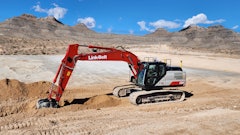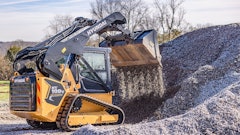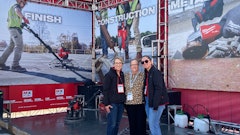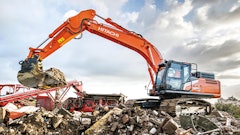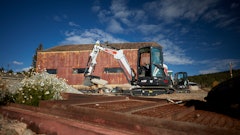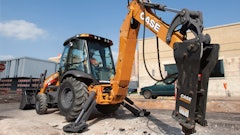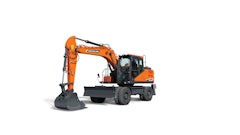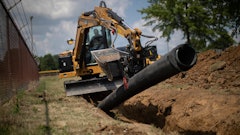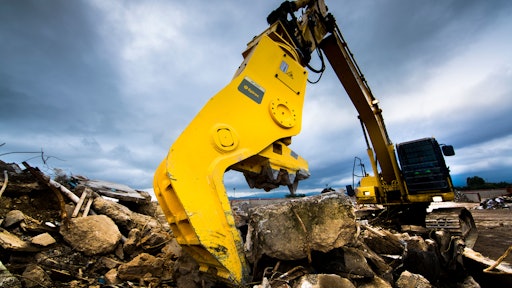
Excavators paired with demolition attachments are the primary workhorses on modern demolition sites. Maximum efficiency requires selecting the right attachment for the job, properly sizing the excavator for the tool and ensuring the operating flows and pressures are adjusted for optimum performance.
Excavators are typically modified to meet specific demolition requirements. “The machine/tool interface, type of tool and the guarding really require a higher degree of coordination with the customer to meet their requirements,” says Kurt Moncini, senior product manager, Komatsu America. “What you are doing and how fast you have to get it done dictates how much machine modification is required to provide an acceptable solution to the project.”
Modifications can be extensive. “Some completely replace the undercarriage with hydraulically expandable tracks,” says Moncini. “This squares up the undercarriage, giving you basically the same capacity over the front as you have over the side.”
Match Excavators to the Tools
When pairing demolition attachments to excavators, take into consideration the attachment weight, center of gravity and hydraulic flow and pressure requirements. “Different demolition tools have different weights and centers of gravity, changing the stability and reach of the excavator,” says Marcus Barnes, construction equipment division, Liebherr USA Co.
 The size of the tool required depends on the type of material to be processed. Make sure that the tool is compatible with the machine in terms of the design and lift requirements.
The size of the tool required depends on the type of material to be processed. Make sure that the tool is compatible with the machine in terms of the design and lift requirements.
There are two real considerations when selecting the maximum weight of an attachment. “One is the stability of the base carrier,” says Moncini. “Then you have the type of structure that the tools go on. There is a big difference between a typical excavator boom and arm and a specialized high-reach package.”
These structures are designed to handle a maximum weight. The greater the reach and height, the smaller the tool mass becomes. “The goal is to reach a very efficient combination of strength and structure that is light and compact enough to reach these high places,” says Moncini.
The attachment size required depends on the type of material. “Make sure that the tool is compatible with the machine’s design and lift requirements,” says Moncini. “Once you get the machine and tool sized correctly, it is just a matter of making sure you have the correct hydraulics.”
Start with the Attachment
The attachment starts to drive the decisions when you get into applications such as cutting structural I-beams with shears. “Those types of applications require bigger machines because you need brute force and hydraulic power to run that great big pair of scissors through an I-beam,” says Moncini.
Shears usually have a large cylinder. “It takes a lot of oil to move that cylinder,” Moncini notes. “Considerable planning goes into looking at the hydraulics to make sure flows can be combined and the shear cycles correctly.” You want high pressure when you cut and high flow to open it back up quickly.
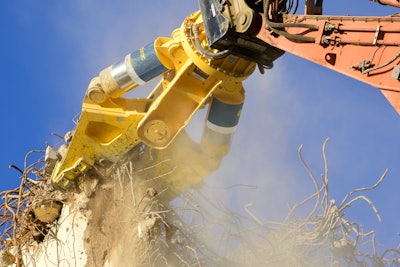 A combi cutter offers different jaw sets to tackle varying job conditions. The fewer tools you have to purchase, the less money out of your pocket.
A combi cutter offers different jaw sets to tackle varying job conditions. The fewer tools you have to purchase, the less money out of your pocket.
You also want to compare attachment options. “Each contractor has their own way of attacking each jobsite. We see more people moving to a versatile tool that has different jaw sets so they can tackle different job conditions,” says Elliott. “Obviously, the fewer tools you have to purchase, the less money out of your pocket. At one point in time, everyone had a dedicated machine for a hydraulic hammer or a shear.” Now demolition contractors tend to make their machines more versatile with multipurpose attachments.
There is no single solution; find the tools that work for you. “Two demolition contractors 50 miles apart might approach their jobs completely different because they believe their system works best for the equipment they have,” says Moncini.
 A hammer will provide years of trouble-free service when carefully paired to the appropriate carrier. Troubleshooting the hydraulic system to ensure proper flows and pressures will help prevent excessive heat buildup and vibration that can damage both the attachment and the carrier.
A hammer will provide years of trouble-free service when carefully paired to the appropriate carrier. Troubleshooting the hydraulic system to ensure proper flows and pressures will help prevent excessive heat buildup and vibration that can damage both the attachment and the carrier.
“The size of the existing carrier is sometimes the main criteria for hammer selection, narrowing the choices to those that fit your carrier,” says Greg Smith, marketing communications manager, Okada America Inc. “Typically, customer-owned carriers can be equipped with the proper size hammer without any problems. Formulas using the weight of the hammer vs. the carrier’s weight are needed to ensure proper sizing. Fitting existing carriers is a typical request. After all, a hammer may be one of four or five attachments for one carrier.
“Hydraulic hammers have evolved with revolutionary seal technology, better steel and closer tolerances,” he continues. “Periodic greasing, monitoring lower bushing wear and tool wear is about all that the hammer requires. A hammer will provide years’ worth of trouble-free service provided it is carefully paired to the appropriate carrier.”
This is where many problems develop. “If the carrier’s hydraulic system is not set up properly, excessive heat buildup and vibration can not only damage the hammer but the carrier, as well,” says Smith. “Properly trouble-shooting the hydraulic system to ensure proper flows and pressures eliminates these problems.”
Match Flow and Pressure Requirements
Demolition tools tend to have high hydraulic demands. “Make sure the excavator has enough hydraulic flow and pressure to supply the demolition tool enough oil to operate efficiently,” says Barnes. “Make sure the machine has enough lift capacity to handle the demolition tool at max reach of the excavator, including the additional reach the length of the tool adds. You will also want to ensure that the excavator bucket and stick cylinder have enough power to operate the tool without putting undue stress on the cylinders.”
Don’t forget auxiliary hydraulic demands. “To run most hydraulic-powered demolition attachments, you will need an additional hydraulic circuit,” says Barnes. “You will also need an additional rotational circuit if that tool is capable of turning 360°.”
Setting flows and pressures for specific attachments has been greatly simplified with the latest generation of machines. “A lot of the newer excavators have electronic controls that control the hydraulic flow and oil pressure,” says Elliot. “Some are extremely accurate and some are not. But once you have them preset to match each specific attachment, you can program the machine for a particular combi-cutter, hydraulic breaker or crusher and name them.”
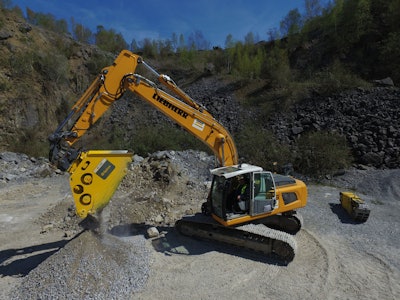 When pairing demolition attachments to excavators, take into consideration the demolition attachment weight, center of gravity and hydraulic flow and pressure requirements.
When pairing demolition attachments to excavators, take into consideration the demolition attachment weight, center of gravity and hydraulic flow and pressure requirements.
Don’t merely rely on what the electronic system is telling you. “If you don’t utilize a hydraulic flow meter to make sure it is within the operating parameters of the attachment, you don’t know if it is correct or not. Electronics are not always 100% when you go to set up the auxiliary circuit,” Elliott points out. “A flow meter is the biggest savior to making sure the equipment will last a long time and you will get better production and reliability out of the unit.”
Double check all settings. “Make sure the attachment has priority flow so that if the operator moves another function while operating the attachment, the oil flow going to the attachment is consistent as opposed to dropping off,” Elliott advises.
“A common mistake is to choose a tool that consumes more power than the base carrier can provide, or a tool that is bigger than the base carrier can handle,” Moncini comments.
“Demolition tool manufacturers usually give you an optimal hydraulic oil flow range that is needed to run their tool, which the excavator will have to be capable of achieving,” says Barnes. “This affects how fast the hydraulic oil will get to the tool for opening and closing. Most demolition contractors like to have the flow set at the high end of the range to have a fast closing time for the tool.”
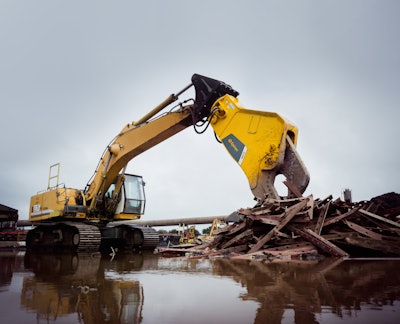 When you get into applications like cutting structural I-beams with shears, the tool starts to drive the decisions since the tool requires high flow and pressure to ensure acceptable cycle times.
When you get into applications like cutting structural I-beams with shears, the tool starts to drive the decisions since the tool requires high flow and pressure to ensure acceptable cycle times.
The design of an attachment has a large impact on performance. “With our combi-cutters, we have two moving jaws and two moving cylinders,” says Elliott. “If you were using our combi-cutter to crush a piece of concrete, if one jaw has made contact with the structure and the other has not, the one jaw that has made the contact will stop moving. The other jaw will catch up, and then once it builds pressure against the piece of material, both jaws will move and crush that piece of material or cut it. Therefore, you are not jerking the carrier around.
“If you have one cylinder and one moving jaw, when the moving jaw is in contact with the material, you still have to take that jaw and push it up to the non-moving jaw,” he continues. “Then you start twisting and jerking the carrier around.”
You also need to understand weight restrictions. People often just looking at the machine weight when picking demolition attachments and don’t look at boom and stick length. “Demolition tools add additional reach to a machine,” says Barnes, “and that paired with an excavator that has a long boom and stick can make a machine tippy if you put too heavy a tool on the machine.”
High Reach Requires More attention
In high-reach applications, the weight of the attachment is critical. “If the tool is too heavy, you will be able to lift the high-reach attachment off the ground, but once you try to stick out with the tool, you may start noticing the machine is unstable while operating,” says Barnes. “Also, too heavy of a tool can lead to overloading the bucket and stick cylinders, which could lead to premature failing.”
“Typically [with high-reach excavators], the tools are downsized to match the lifting capacity when the boom and stick(s) are fully extended,” says Elliott. Always reference the specifications of the high-reach equipment to ensure that the tool is appropriate with the specific high-reach configuration.
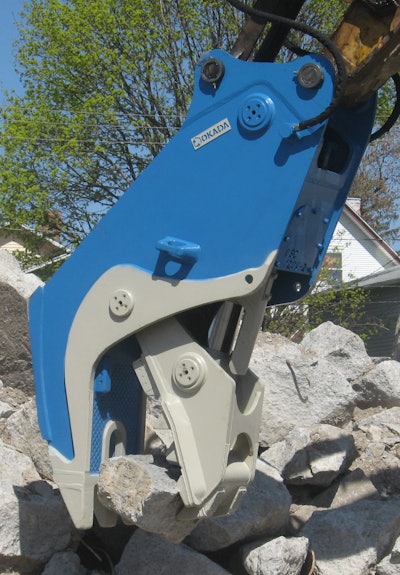 Make sure the carruer has enough lift capacity to handle the demolition tool at maximum reach, taking into account the added reach provided by the attachment.
Make sure the carruer has enough lift capacity to handle the demolition tool at maximum reach, taking into account the added reach provided by the attachment.
Nothing can replace operator skill. “You have this incredibly expensive machine. You need someone with great hand/eye coordination and depth perception because they may have that tool 80 ft. up in the air, trying to grab a beam or a piece of concrete structure with the tool correctly aligned,” says Moncini. “You need [an operator] with good situational awareness.”
The goal is to work up high with the machine positioned just far enough back for safe operation. “You get into some really unique modifications — cabs that tilt back, cabs that elevate,” says Moncini. “One thing people don’t think about is how much dust there is. It is common to find excavators with buckets replaced by water cannons to wet the working area down for dust control. Other times, you may find machines modified with water lines that extend to the top of these high-reach machines.”
“Because of the extraordinary high reach these machines have and risk of tipping over, high-reach excavators are equipped with safety systems that monitor the high-reach attachments to make sure the excavator is not in danger of tipping,” says Barnes. “We call our system Liebherr Demolition Control (LDC).”
The LDC system uses a separate touchscreen similar to that used in Liebherr cranes. It continuously monitors the high-reach attachment using different sensors located on the attachment. “If the operator gets into an uncompromising position, the LDC system will not let the operator make any further movements until the machine is back into a safe working position,” says Barnes.
The LDC system offers two modes of operation. “One mode is a restricted mode where an operator will not be able to put the machine into an uncompromising position,” Barnes explains. “If the operator reaches the high-reach limitation, he will not be able to go any further until the machine is put back into a safe position. Then there is a mode where a more experienced high-reach operator will be able to run the machine without restrictions. This mode is called Supervisor Mode. In my experience, most operators run the machine in a restricted mode until they learn the limits of the machine.”















